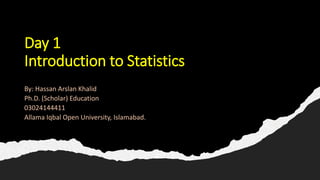Chapter 1
This document provides an introduction to statistics, including defining key terms and concepts. It discusses what statistics is, the difference between populations and samples, parameters and statistics. It also outlines the two main branches of statistics - descriptive statistics, which involves organizing and summarizing data, and inferential statistics, which uses samples to draw conclusions about populations. The document then discusses different types of data, such as qualitative vs. quantitative, and the four levels of measurement for quantitative data. Finally, it discusses methods for designing statistical studies and collecting data, such as interviews, questionnaires, observation, and using registration data or mechanical devices.

Recommended
Recommended
More Related Content
What's hot
What's hot (20)
Similar to Chapter 1
Similar to Chapter 1 (20)
Recently uploaded
Recently uploaded (20)
Chapter 1
- 1. Day 1 Introduction to Statistics By: Hassan Arslan Khalid Ph.D. (Scholar) Education 03024144411 Allama Iqbal Open University, Islamabad.
- 2. Chapter Outline An overview of statistics Data classification Experimental design
- 3. Section 1 An overview of Statistics
- 4. Learning Outcomes • Define statistics • Distinguish population and sample • Distinguish a parameter and a statistic • Distinguish descriptive and inferential statistics
- 5. What is data? • Data consists of information coming from observations, counts, measurement, or responses. • “People who eat three daily servings of the whole grains have been shown to reduce their risk of … stroke by 37 %.” (Source: Whole Grains Council) • “Seventy percent of the 1500 IT students playing DOTA 2 and CSGO”
- 6. What is Statistics? • Statistics: Statistics is a branch of knowledge that deals with facts and figures. The term statistics refers to a set of methods and rules for organizing, summarizing, and interpreting information. It is a way of getting information from data.
- 7. Data Sets • Population The collection of all outcomes, responses, measurements or counts that are of interest. • Sample A subset of population.
- 10. Parameter and Statistic Parameter • A number that describes a population characteristic. • Average age of all people in Pakistan. Statistic • A number that describes a sample characteristic. • Average age of people from a sample of 2 provinces.
- 13. Branches of Statistics • Descriptive Statistics Involves organizing, summarizing and displaying data. e.g., tables, charts, averages. • Inferential Statistics Involves using sample data to draw conclusions about a population.
- 14. Example • Let’s say there are 20 statistics classes at your university, and you’ve collected the ages of students in one class. Ages of students in your statistics class: 19, 21, 18, 18, 34, 30, 25, 26, 24, 24, 19, 18, 21, 49, 27. A descriptive question that could be asked about this data: “What’s the most common age of student in your statistics class?” The answer of this would be 18. An inferential question could be: “Are the ages of students in this classroom similar to what you would expect in a normal statistics class at this university?
- 16. Learning Outcomes • Distinguish between qualitative and quantitative data • Classify data with respect to four levels of measurement
- 17. Types of Data According to Sources • Primary Data Refers to information which is directly gathered from respondents, or which is based on direct or firsthand experiences. Example: diary • Secondary Data Refers to information which is taken from published or unpublished data gathered by other individuals or agencies. Example: books, magazines
- 18. Types of Variables • Qualitative Variables Consist of attributes, labels or non-numerical entries. Examples: Major, Place of birth, Eye color • Quantitative Variables Numerical measurements or counts. Examples: Temperature, Age, Weight of object.
- 21. Classification of Quantitative Variables • A numerical response that arise from a measurement process. • Example: 1.2 inches, 2.8 cm. Continuous Data • Numerical responses that arise from a counting process. • Example: Number of children in a community. Discrete Data
- 22. Levels of Measurement • Nominal Level of Measurement • Qualitative data only • Categorized using names, labels or qualities • No mathematical computations can be made • Ordinal Level of Measurement • Qualitative or quantitative data • Data can be arranged in order • Differences between data entries in not meaningful
- 25. Levels of Measurement • Interval Level of Measurement • Quantitative data • Data can be ordered • Differences between data entries is meaningful • Zero represents a position on scale (not an inherent zero – zero does not imply “none”
- 27. Levels of Measurement • Ratio Level of Measurement • Similar to interval level • Zero entry is an inherent zero (implies “none”) • A ratio of two data values can be formed • One data value can be expressed as a multiple of other
- 30. Section 3 Discuss how to design a statistical study Data Collection Techniques Sampling Techniques
- 31. Methods of Data Collection • Interview Method • Direct Method: The researcher personally interview the respondents. • Indirect Method: The researcher uses a telephone call to interview the respondents. • Questionnaire Method It is a list of well – planned questions written on a paper which can be either personally administered or mailed by the researcher to respondents. • Observation Method The researcher observes the subject of study which may be an individual, a group, or any unit of interest.
- 32. Methods of Data Collection • Registration Method Example of data gathered using this method are those obtained from National Statistics Office (NSO), Land Transportation, Education Department, and other Government Agencies. • Mechanical Devices Devices that can be used when gathering data for social and educational researches like camera, projector, tape recorder etc.
- 42. Summary